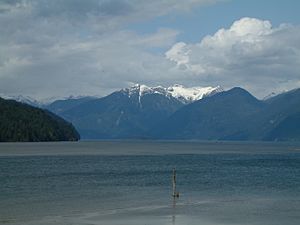Pitt Lake facts for kids
Quick facts for kids Pitt Lake |
|
|---|---|
 |
|
| Location | British Columbia |
| Coordinates | 49°25′N 122°33′W / 49.417°N 122.550°W |
| Type | Fjord lake |
| Primary inflows | Pitt River |
| Primary outflows | Pitt River |
| Basin countries | Canada |
| Max. length | 24 km (15 mi) |
| Max. width | 4.5 km (2.8 mi) |
| Surface area | 53.5 km2 (20.7 sq mi) |
| Surface elevation | 3 m (9.8 ft) |
| Islands | Goose, Little Goose, Gosling |
Pitt Lake is a large and interesting lake in British Columbia, Canada. It's the second-biggest lake in the Lower Mainland area. The lake covers about 53.5 square kilometers. It is around 25 kilometers long and about 4.5 kilometers wide at its widest point.
What makes Pitt Lake special is that it's one of the few lakes in the world that has tides! This means its water level goes up and down with the ocean tides, even though it's a lake. On average, the tide in Pitt Lake changes by about one meter (three feet). This happens because the lake is connected to the Pitt River and the Strait of Georgia, which have much bigger tides. The southern end of Pitt Lake is about 20 kilometers upstream from where the Pitt River meets the Fraser River. It's also about 40 kilometers east of Downtown Vancouver.
Contents
How Pitt Lake Was Formed
Pitt Lake sits in a valley that looks like a "U" shape. This shape was carved out by huge glaciers during the Wisconsin glaciation (a time when much of the Earth was covered in ice). The glaciers dug out the bottom of the valley, making it very deep – more than 140 meters (460 feet) below today's sea level.
After the glaciers melted about 13,000 years ago, the basin was filled with saltwater, like a fjord. But around 10,500 years ago, the Fraser River started to drop a lot of sand and mud. This sediment partly blocked the connection to the ocean. Because of this, Pitt Lake is now known as a tidal fjord lake.
Pitt Lake is one of several long, narrow lakes in this region that run north to south. These lakes were also formed by glaciers. The biggest of these is Harrison Lake, located about 60 kilometers to the east. Other similar lakes include Coquitlam Lake, Alouette Lake, Stave Lake, and Chehalis Lake.
The Pitt River flows into the northern end of Pitt Lake. The land along the western side of Pitt Lake is protected as part of Pinecone Burke Provincial Park. Most of the eastern shore is protected within Golden Ears Provincial Park. At the southern end of the lake, there's a large marshland area called Pitt Polder. While much of this marshland has been drained for farming, the northern part is kept safe. It's a very important home for birds that travel long distances (migratory birds).
Nearby Communities
At the southern end of Pitt Lake, you'll find the community of Pitt Meadows and the Pitt Lake Indian Reserve 5, which is a First Nations reserve. Just southwest of the lake is Port Coquitlam, located across the Pitt River from Pitt Meadows. At the very north end of the lake, there's a small place called Alvin. This spot is used by logging companies to transport goods and people.
Climate Around Pitt Lake
Pitt Lake has an oceanic climate. This means it usually has cool, rainy winters and summers that are relatively warm and dry. The area gets a lot of rain, with an average of about 2155.4 millimeters (84.86 inches) of precipitation each year.
The temperatures can vary quite a bit. The coldest temperature ever recorded was -23.3°C (-9.9°F) on January 23, 1969. The hottest temperature recorded was 37.0°C (98.6°F) on July 21, 2006.
Fun Things to Do at Pitt Lake
Pitt Lake is a popular spot for people who love to go boating and canoeing. However, it's important to be careful because the lake can get very windy. Strong winds can create big waves, especially because the lake is so deep.
The area upstream from the lake, known as the Upper Pitt, is famous for fishing. It's considered one of British Columbia's best rivers for fly-fishing and for catching steelhead fish.
If you enjoy golfing, there's also a golf resort called Swan-e-set in the Pitt Polder area near the lake.
The Legend of Lost Gold
The eastern side of Pitt Lake is known for a famous local story about a lost gold mine. The legend says that a man named Slumach had a secret gold mine somewhere in this area. Many people have tried to find this mine over the years, but they have all failed, and some searches have even ended badly.
A local historian named Bill Barlee has said that even though this story is very exciting and many treasure hunters believe it, the gold mine probably doesn't exist. Geologists, who study the Earth's rocks, also believe that it's unlikely to find gold in the Pitt Lake region. So, the story of the lost mine of Pitt Lake is a legend without scientific proof.
See also
 In Spanish: Lago Pitt para niños
In Spanish: Lago Pitt para niños


